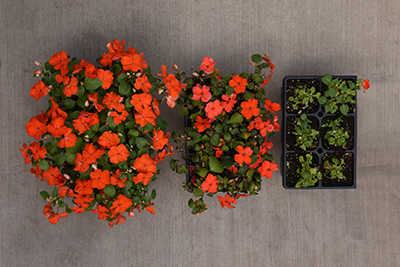U.S. Utility Patent Granted For Beacon™ Impatiens
Lisa Lacy Portfolio Manager
The exciting news for Beacon™ Impatiens continues! PanAmerican Seed is thrilled to announce that a United States utility patent was granted for Beacon Impatiens having a unique form of disease resistance to Impatiens downy mildew. US10,285,362 covers all six colors and the two mixes of Beacon Impatiens. Additional patent applications are pending, and we’ll be sure to keep you updated on these developments.
Receiving this patent really underscores confidence in this product. Being able to bring such an important flower class back to the market is a shining moment in our industry.
Below are a few additional details from the USPTO, along with the general background on the invention of Beacon Impatiens. For full details on this product launch, visit www.BeaconImpatiens.com.

US10,285,362
Impatiens walleriana having Impatiens downy mildew resistance as sourced from seed deposit; commercial plants can be identified through markers. See the USPTO Patent Full-Text and Description here.
Background of the invention:
Impatiens downy mildew, caused by Plasmopara obducens, is a destructive foliar disease of Impatiens walleriana that is capable of causing complete defoliation or plant collapse, especially in landscape plantings under moist conditions and cool nights.
Regional outbreaks of this disease were seen for the first time in landscape beds and container plantings in North America in summer 2011. By the end of the 2012 season, Impatiens downy mildew had been confirmed in 34 states. However, the occurrence and timing of when the disease was observed within a geographic region was highly variable. In 2013, the distribution of the disease was widespread and similar in distribution to the previous two years, with the addition of infected landscape beds in regions of Colorado, Kansas, Utah and Hawaii. In most regions of the country, the occurrence of the disease in 2013 and 2014 was late in the season, similar to what was observed in 2011. Each year since, the disease has been observed in landscapes across the United States and lower Canada. The occurrence is earlier in the southern states (November-February) and later in the northeast and upper midwest (August-October).
Hosts include all cultivars of Impatiens walleriana, the common garden impatiens, and interspecific hybrids with an I. walleriana parent are susceptible. A few wild species of impatiens are also susceptible; however, there are no other bedding plant species that are known hosts. Both vegetative propagated and seed-raised I. walleriana are susceptible but there is no evidence of seedborne transmission of P. obducens. New Guinea impatiens, Impatiens hawkeri, including Divine, Celebration, Celebrette, and Sunpatiens series have high resistance to this disease.
Sporangia, sac-like structures filled with zoospores, produced on the underside of infected leaves are easily dislodged and can be spread short distances by water splash, and longer distances by air currents. Infected plants not yet showing symptoms may result in the inadvertent movement of the pathogen into greenhouse production facilities or the landscape.
Young plants and immature plant tissues are especially susceptible to infection. Symptoms are often first observed on terminal growth. Seedling cotyledons are highly susceptible to infection. Early symptoms include light-green yellowing or stippling of leaves, downward curling of infected leaves, and white downy-like fungal growth on the undersides of leaves. Advanced symptoms include stunting in both plant height and leaf size when infected at an early stage of development, leaf and flower drop resulting in bare, leafless stems, and infected stems become soft and plants collapse under continued wet and cool conditions as found in landscape plantings. (Warfield C., Impatiens Downy Mildew; Guidelines for Growers, 2014; Warfield, C. Downy Mildew of Impatiens, GrowerTalks, 2011).


